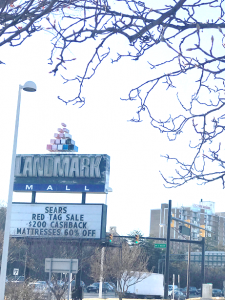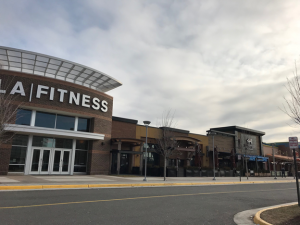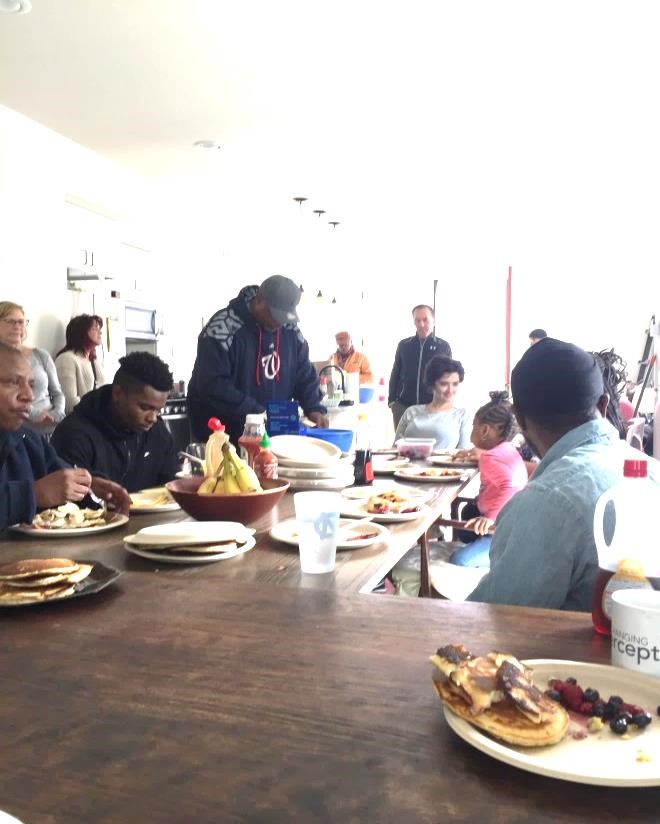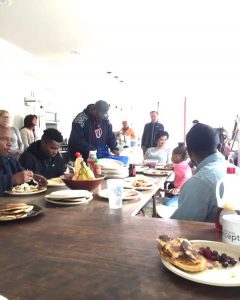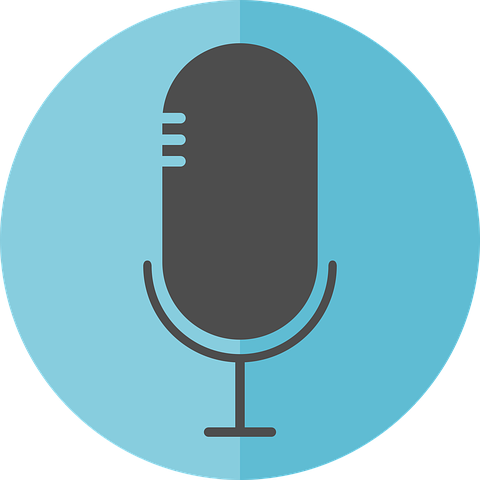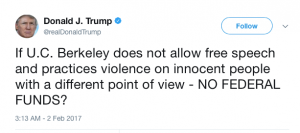
I prepared for the obligatory gift-giving of the holiday season by visiting three malls in the suburbs of Washington D.C. I planned to check-off all of the names on my shopping list and not wait until the last minute to find gifts (for once). I did not find many gifts at the malls and instead relied on Amazon Prime to deliver gifts with a few days to spare; however, I was surprised that the malls were busy. The hustle and bustle that I experienced seemed to counter the dominant media narrative of dying and dead malls in the U.S.
Media reports of major retailers, such Sears, Macy’s, and JCPenney, closing their doors have become a regular occurrence. These closures have fed a narrative that the death of the mall –the large enclosed shopping center– is near in this age of online shopping and minimalist millennials. The closing of major anchor stores is indicative of, or at least often conflated with, the death of the traditional mall itself. The oft-used phrase is typically paired with ominous photographs or videos of empty stores and in some cases abandoned buildings. For example, the website deadmalls.com is dedicated to archiving the death of malls across the U.S. with stories and images. Once synonymous with the image of a booming postwar society characterized by flourishing capitalism, unbounded American dreams, and the assertion of the individual through mass consumption, malls now seem to be a remnant of a bygone era.
The Life of the Indoor Shopping Mall
While indoor shopping centers first appeared in the U.S. as early as the first half of the 19th century, large-scale enclosed suburban shopping centers characterized as “the mall” today did not appear until much later (O’Malley 2016). Historian Lizabeth Cohen (1996) explains that in the 1940s and 1950s, there was a large shift in the population distribution of American citizens as predominantly white families began moving into newly developing suburban areas. With only a small number of local shops located in town centers, these newly developing suburbs were unable to keep-up with the growing demands of a larger population. Many people living in the suburbs had to make trips to nearby cities to buy products until developers began to take advantage of the residents’ growing need for a shopping center. Cohen (1996: 1052) describes the emergence of the new postwar marketplace:
“By the mid-1950s, however, commercial developers–many of whom owned department stores–were constructing a new kind of marketplace, the regional shopping center aimed at satisfying suburbanites’ consumption and community needs. Strategically located at highway intersections or along the busiest thoroughfares, the regional shopping center attracted patrons living within half an hour’s drive, who could come by car, park in the abundant lots provided, and then proceed on foot.”
One such marketplace is Southdale Center, which opened in Edina, Minnesota in 1956; it was the first fully enclosed and climate-controlled suburban shopping mall in the U.S. Designed by architect Victor Gruen, Southdale Center was intended to “bring European sensibilities stateside by dramatically blurring the lines between shopping, socialization, leisure, and play” (Newton 2017:6). Gruen’s design, although never fully realized, would act as the prototype for what we now identify as “the mall.”
As Cohen (1996) explains, after WWII, the move from “town center” to “shopping center” was an intentional transition to combine both consumption and civic activity into an all-in-one center. Despite the narrative that the indoor mall was a public space where all members of the community, especially women, could tend to needs and wants (shopping for the family, recreation, and community activities), the indoor mall acted as a regulated and segregated space intended for middle-class whites; those with a low socioeconomic status and people of color were not welcome in this space. Eventually, the mall as a community center became “too political” for private owners because it was also a strategic location for free speech and demonstrations (ibid.). Therefore, mall owners transitioned away from the community model to focus more intently on consumerism. Gruen, who is now known as the creator of the modern shopping mall, would later state that his original design and ideas were “bastardized” by modern developments, devoid of rich community life (Newton 2017; O’Malley 2016).
There was a significant increase in the number of shopping malls and shopping centers in general in the 1960s into the late 1980s (Feinberg and Meoli 1991). O’Malley (2016) writes that the construction of enclosed malls reached its height in 1990 but subsequently decreased through the 2000s. This decline is indicated by the fact that in 2007, “for the first time in more than 40 years, no new malls opened in the United States” (O’Malley 2016:4).
According to retail analysts, the decline of the mall is due to factors such as online shopping, the closing of anchor stores, retiring/retired Baby Boomers, more women in the workforce, teens spending less time at the mall, mall saturation, mall consolidation, and outstanding loans from the indoor mall building boom of the 1990s. While some top-tier traditional malls may be able to adapt to changing socioeconomic conditions by incorporating entertainment and technology into the space, other traditional malls may not have the funds to do so (ibid.).
It is important to note that the “death” of the traditional indoor mall is not necessarily an indication that consumers only want virtual shopping experiences. Preferences regarding online shopping and physical shopping are complex. For example, some corporations associated with an online presence, such as Amazon, are opening “brick-and-mortar stores.” This trend is due in part to consumers’ desires to tangibly experience a product before they purchase it in addition to the immediacy of the transaction (ibid.).
From Traditional Mall to Town Center
My shopping experiences for holiday gifts point to larger questions regarding the evolution of malls locally and in the U.S. more generally. Why do malls in the Washington D.C. suburbs appear to be thriving, and why are malls now often referred to as town centers? There seems to be a turn back to the town center brand and romanticized notions of community along with it.
Before the indoor shopping mall, the town center played a prominent role in suburbia where residents would purchase their products downtown at local shops that were not located in one large building (Cohen 1996). Fung and Safdar (2018) explain that many malls are undergoing makeovers and dropping “mall” from their names, citing Ballston Common Mall in Arlington (Virginia) and its recent renovation plans to become Ballston Quarter in 2018 as an example of this rebranding.
Springfield Town Center (in Virginia) is another local example of this image overhaul. Springfield Mall, which opened in the 1970s, underwent a multimillion dollar renovation from 2012-2014, also dropping “mall” from its name.
The moniker “town center” signifies how the mall is changing; it is not simply a site of consumption but a place of experiences and particular lifestyles. In explaining the changing image of the mall, O’Malley (2016:17) notes: “Over-the-top, non-retail experiences, from unique restaurants to indoor swimming pools will be as ubiquitous as the stores, and most malls will incorporate apartments, offices and service providers like doctors, barbers, gyms and hotel rooms into or next to their space.”
Town Centers for the Community
An important aspect of the life trajectory of a mall is related to how it serves the larger community. The turn back to the “town center” tag and the connotations it evokes seems to suggest a move to incorporate malls within the town or the communities of which they are a part, as opposed to operating as isolated and contained consumer locations. For example, Landmark Mall in Alexandria (Virginia), built in the 1960s, is currently undergoing renovations to become the “new Landmark,” described as “a new live-shop-dine urban village” (see the website thenewlandmark.com).
The new Landmark’s homepage emphasizes that the renovations will benefit the community and that the corporate owner “is dedicated to transforming it and bringing back a sense of community” to the area. It is important to consider how these developments affect the surrounding areas in the name of “the community.” What roles are these town centers actually playing in the communities in which they insert themselves? Will they actually foster community cohesion? What does it mean for nearby housing prices? Will these renovated spaces create more jobs or will the number of jobs shrink? How might the arrival of national retail outlets, restaurants, and entertainment venues impact local culture and businesses? In the Washington D.C. suburbs, town centers may be the eventual future of the indoor mall and perhaps even necessary for its survival, but it is also important to consider what incarnations indoor malls or town centers in more rural areas may take, based on (perceived or real) community needs and wants.
References
Cohen, Lizabeth. 1996. “From Town Center to Shopping Center: The Reconfiguration of Community Marketplaces in Postwar America.” American Historical Review 101(4):1050-81.
Feinberg, Richard A. and Jennifer Meoli. 1991. “A Brief History of the Mall.”Advances in Consumer Research 18 (1): 426-27.
Fung, Esther, and Khadeeja Safdar. 2018. “Please Visit Our Collection of Stores Under One Roof, Which Totally Isn’t a Mall.” The Wall Street Journal. Retrieved January 15, 2018 (https://www.wsj.com/articles/please-visit-our-collection-of-stores-under-one-roof-which-totally-isnt-a-mall-1515686374?mod=e2tw).
Newton, Matthew. 2017. Shopping Mall (Object Lessons). New York, NY: Bloomsbury Academic.
O’Malley, Sharon. 2016, August 29. “Shopping Malls.” SAGE Business Researcher. Retrieved from (http://businessresearcher.sagepub.com/sbr-1775-100682-2747282/20160829/shopping-malls) doi: 10.1177/237455680217.n1
By Briana Pocratsky

